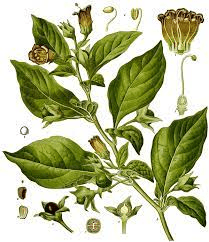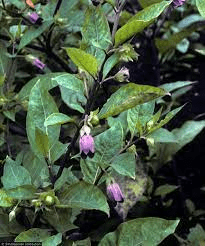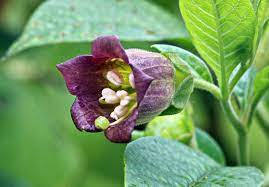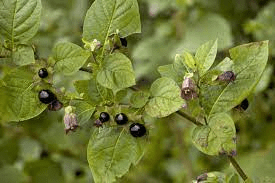Atropa belladonna, commonly known as Belladonna, Deadly Nightshade, or Devil’s Berries, is a highly toxic perennial herbaceous plant belonging to the Solanaceae family. Native to Europe, North Africa, and Western Asia, Belladonna has a long history of both medicinal and toxicological significance.
Morphologically, Belladonna grows to a height of about 1 to 1.5 meters and has large, ovate leaves that are dark green in color. The plant produces bell-shaped, purple or reddish-brown flowers, followed by shiny black berries that are about the size of cherries.
The plant contains tropane alkaloids, including atropine, scopolamine, and hyoscyamine, which are responsible for its toxic properties. In controlled and highly diluted forms, these alkaloids have been used in traditional medicine for their antispasmodic and analgesic properties.
However, due to the narrow therapeutic window and the potential for severe toxicity, the medicinal use of Belladonna is highly controversial and generally discouraged.
Historically, Belladonna has been associated with various folk beliefs and practices. The name “belladonna” means “beautiful woman” in Italian, and extracts of the plant were historically used by women in small doses to dilate their pupils, giving the appearance of larger, more attractive eyes. This use, however, is extremely dangerous and not recommended due to the toxicity of the plant.
In modern times, Belladonna and its alkaloids have limited and highly regulated applications in the pharmaceutical industry. Atropine, derived from Belladonna, is used in minute quantities in certain medications, particularly for ophthalmic purposes to dilate the pupils and in some cases of bradycardia (slow heart rate).
Despite its historical and limited modern applications, Belladonna is considered highly toxic and poses a significant risk of poisoning. Ingesting any part of the plant, especially the berries, can lead to severe toxicity and potentially fatal outcomes. Accidental ingestion should be treated as a medical emergency, and immediate medical attention is necessary.
Due to its extreme toxicity and the availability of safer alternatives, the use of Belladonna in any form for self-medication or recreational purposes is strongly discouraged. It is crucial to exercise caution and seek professional medical advice if there is any suspicion of Belladonna exposure or poisoning.
The Botanical Description of Belladonna
1. Appearance: Belladonna, scientifically known as Atropa belladonna, is a perennial herbaceous plant with distinctive features. It has large, ovate leaves that are often dark green in color. The plant produces bell-shaped flowers, which can be purple or greenish in hue, and shiny black berries when ripe.
2. Height: Belladonna typically reaches a height of 3 to 4 feet, showcasing a robust and upright growth habit. The stem is sturdy, often branching as it rises from the ground.
3. Leaves: The leaves of Belladonna are characterized by their smooth texture and prominent veins. They are arranged alternately along the stem and can grow up to 10 inches in length.
4. Flowers: Belladonna’s flowers are nodding and bell-shaped, featuring five lobes. The color can vary, with shades of purple, violet, or greenish-white. The blooms are not only aesthetically intriguing but also an essential part of the plant’s reproductive cycle.
5. Berries: The plant’s berries are glossy black and, though tempting in appearance, are highly toxic. They contain the plant’s potent alkaloids and should never be ingested.
6. Root System: Belladonna has a well-developed root system that extends into the soil. The roots play a crucial role in nutrient absorption and anchoring the plant.
7. Alkaloid Content: The most significant botanical feature of Belladonna is its alkaloid content. The plant contains tropane alkaloids, including atropine, scopolamine, and hyoscyamine, which contribute to its medicinal properties.
8. Habitat: Belladonna is native to Europe, North Africa, and Western Asia. It thrives in damp, shaded areas such as woodlands, preferring rich, well-drained soils.
9. Blooming Season: Belladonna typically blooms in late summer to early fall, attracting attention with its unique and somewhat ominous appearance.
The Geographic Distribution of Belladonna

1. Native Regions: Belladonna is native to parts of Europe, including the United Kingdom, as well as North Africa and Western Asia. It has adapted to diverse climates within these regions.
2. Europe: Within Europe, Belladonna can be found in countries such as Germany, France, and Italy. It has historical significance in European herbalism.
3. North Africa: Belladonna extends into North African regions, where it may be found in certain wooded areas and along the fringes of cultivated land.
4. Western Asia: The plant’s distribution encompasses parts of Western Asia, where it may thrive in specific habitats with suitable conditions.
5. Naturalization: Belladonna has been introduced and naturalized in other parts of the world, including North America, where it is considered an invasive species in some regions.
6. Growing Conditions: The plant prefers temperate climates and is often found in damp, shaded locations, such as the edges of forests or wooded areas with rich, well-drained soil.
7. Altitude Range: Belladonna can be found at various altitudes, adapting to conditions ranging from lowland areas to higher elevations.
8. Invasive Characteristics: In regions where it has been introduced, Belladonna can spread rapidly and become invasive, competing with native vegetation.
The Chemical Composition of Belladonna
1. Tropane Alkaloids: Belladonna’s primary chemical constituents are tropane alkaloids, including atropine, scopolamine, and hyoscyamine. These alkaloids contribute to the plant’s medicinal properties and toxicity.
2. Atropine: Atropine is a potent alkaloid found in Belladonna that acts as an antimuscarinic, affecting the muscarinic receptors in the body. It has applications in medicine, particularly in ophthalmology.
3. Scopolamine: Another tropane alkaloid, scopolamine, possesses antimuscarinic properties and is known for its sedative and anti-nausea effects. It has historical uses in both traditional medicine and modern pharmacology.
4. Hyoscyamine: Hyoscyamine is an alkaloid with similar antimuscarinic effects, contributing to Belladonna’s pharmacological actions. It is used in certain medications for various therapeutic purposes.
5. Solanidine: Belladonna may contain solanidine, a steroidal alkaloid. While less studied than tropane alkaloids, solanidine contributes to the plant’s overall chemical profile.
6. Flavonoids: Belladonna may contain flavonoids, secondary metabolites known for their antioxidant properties. These compounds add to the plant’s chemical complexity.
7. Tannins: Tannins, with their astringent properties, may be present in Belladonna. However, their role in the plant’s pharmacological effects is less prominent than tropane alkaloids.
8. Coumarins: Some studies suggest the presence of coumarins in Belladonna, compounds known for their potential pharmacological activities.
9. Essential Oils: While not a primary component, trace amounts of essential oils may be found in Belladonna, contributing to its overall chemical composition.
10. Sterols: Belladonna may contain sterols, which are compounds with diverse physiological effects in plants.
11. Glycosides: Certain glycosides may be present in Belladonna, adding to the complexity of its chemical makeup.
12. Beta-Carboline Alkaloids: Some studies suggest the presence of beta-carboline alkaloids in Belladonna, although research on this aspect is limited.
Read Also: 16 Medicinal Health Benefits Of Rubia (Madder)
The Medicinal Health Benefits Of Belladonna (Atropa belladonna)

1. Pain Relief: Belladonna has been traditionally used for its analgesic properties, particularly in alleviating certain types of pain such as neuralgia and headaches.
2. Anti-Spasmodic Actions: The antimuscarinic effects of tropane alkaloids in Belladonna contribute to its anti-spasmodic actions, making it useful in conditions involving involuntary muscle contractions.
3. Ophthalmic Uses: Atropine, derived from Belladonna, has ophthalmic applications, dilating the pupils and aiding in certain eye examinations and procedures.
4. Respiratory Conditions: Belladonna has been employed in traditional medicine for respiratory conditions, where its anti-spasmodic effects may help alleviate symptoms of cough and asthma.
5. Gastrointestinal Relief: The plant’s anti-spasmodic properties extend to the gastrointestinal tract, providing relief from certain digestive issues characterized by spasms.
6. Motion Sickness: Scopolamine, present in Belladonna, has anti-nausea properties and is used to alleviate symptoms of motion sickness.
7. Parkinson’s Disease: Some studies have explored the potential use of Belladonna derivatives in managing symptoms of Parkinson’s disease, although more research is needed.
8. Fever Reduction: Belladonna has been historically used to reduce fever, with its anti-spasmodic and analgesic effects contributing to this traditional application.
9. Detoxification: In certain traditional practices, Belladonna has been used for detoxification purposes, although this use is controversial and not supported by modern medical evidence.
10. Skin Conditions: Some topical formulations containing Belladonna have been used to address certain skin conditions, although the efficacy and safety of such applications are areas of debate.
11. Anti-Inflammatory Effects: Belladonna may exhibit anti-inflammatory effects, contributing to its use in conditions characterized by inflammation.
12. Pre-anesthetic Medication: Atropine, derived from Belladonna, has been used as a pre-anesthetic medication to reduce salivation and respiratory secretions.
13. Muscle Relaxation: The anti-spasmodic properties of Belladonna extend to muscle relaxation, making it beneficial in certain conditions involving muscle tension.
14. Migraine Relief: Due to its analgesic effects, Belladonna has been historically employed in some traditional practices for migraine relief.
15. Scarlet Fever Support: In historical contexts, Belladonna was used to support individuals with scarlet fever, although the role of modern medicine has evolved in managing this condition.
16. Urinary Incontinence: The anti-spasmodic effects of Belladonna may be relevant in addressing certain types of urinary incontinence.
17. Anti-Parkinsonian Effects: Some studies have explored the potential anti-Parkinsonian effects of Belladonna alkaloids, but further research is needed to establish their efficacy.
18. Psychiatric Uses: In certain historical and traditional contexts, Belladonna was used for its psychoactive effects. However, such uses are not supported by contemporary medical practices.
19. Anti-nausea Effects: Scopolamine, a component of Belladonna, is known for its anti-nausea effects and is utilized in certain medical scenarios.
20. Anti-Secretory Actions: Atropine, derived from Belladonna, has anti-secretory actions that can be beneficial in certain medical procedures and conditions.
The Methods of Usage to Achieve the Provided Health Benefits Of Belladonna (Atropa belladonna)
1. Tinctures: Tinctures made from Belladonna are a common form of administration, allowing for controlled dosage. However, extreme caution is required due to the plant’s toxicity.
2. Homeopathic Preparations: In homeopathy, highly diluted preparations of Belladonna are used for various conditions. Homeopathic formulations aim to harness the plant’s medicinal properties while minimizing toxicity.
3. Topical Creams: Certain topical creams containing Belladonna extracts may be used for localized relief of pain or muscle spasms. However, careful application and adherence to recommended dosages are essential.
4. Atropine Eye Drops: Atropine, derived from Belladonna, is used in ophthalmology as eye drops to dilate pupils for certain diagnostic procedures.
5. Inhalation: Inhalation of Belladonna preparations, although rare, has been employed for respiratory conditions. This method requires professional supervision due to the potential for toxicity.
6. Suppositories: In some medical contexts, suppositories containing Belladonna may be used for rectal administration to address specific gastrointestinal or urological issues.
7. Tablets or Pills: Controlled-release tablets or pills may be formulated with Belladonna for specific therapeutic purposes, providing a measured dosage for oral administration.
8. Liquid Extracts: Liquid extracts, taken in small, carefully measured doses, may be used to harness the medicinal benefits of Belladonna while minimizing the risk of toxicity.
9. Poultices: In traditional applications, poultices containing Belladonna may be applied topically to address localized pain or inflammation. However, this method is less common due to the plant’s toxicity.
10. Controlled Medical Procedures: Some medicinal uses of Belladonna, such as pre-anesthetic administration or specific diagnostic procedures, are carried out under controlled medical settings to ensure safety and efficacy.
The Side Effects Of Using Belladonna Medicinal Plant
1. Toxicity: Belladonna is highly toxic, and even small amounts can lead to severe poisoning. Symptoms of toxicity include dry mouth, blurred vision, hallucinations, convulsions, and respiratory failure.
2. Dilated Pupils: The use of Belladonna or its derivatives, such as atropine, can lead to dilated pupils, causing sensitivity to light.
3. Dry Mouth and Throat: Anti-spasmodic effects of Belladonna can result in dryness of the mouth and throat, leading to discomfort.
4. Increased Heart Rate: Atropine, a component of Belladonna, can cause an increase in heart rate, which may be dangerous for individuals with pre-existing heart conditions.
5. Urinary Retention: Anti-spasmodic actions of Belladonna may lead to urinary retention, making it difficult to empty the bladder.
6. Constipation: Belladonna’s anti-spasmodic effects can extend to the gastrointestinal tract, potentially causing constipation.
7. Hallucinations: In cases of Belladonna poisoning, hallucinations and delirium can occur, posing serious risks to mental health.
8. Confusion: Confusion and disorientation may be experienced as a result of Belladonna toxicity.
9. Increased Body Temperature: Belladonna poisoning can lead to elevated body temperature, posing risks of hyperthermia.
10. Respiratory Distress: Severe Belladonna poisoning can result in respiratory distress and, in extreme cases, respiratory failure.
11. Allergic Reactions: Some individuals may be allergic to Belladonna, leading to allergic reactions such as skin rashes, itching, or swelling.
12. Interactions with Medications: Belladonna may interact with certain medications, including antihistamines, antidepressants, and antipsychotics, leading to adverse effects.
13. Central Nervous System Effects: In cases of Belladonna poisoning, the plant’s alkaloids can affect the central nervous system, leading to symptoms such as seizures, tremors, and altered mental status.
14. Photosensitivity: Some individuals may experience increased sensitivity to sunlight when using Belladonna or its derivatives, necessitating sun protection measures.
15. Dry Skin and Flushing: Dry skin and flushing of the skin can occur as a result of Belladonna’s anti-spasmodic effects.
Read Also: Worm Infestation on Ruminant Animals: Symptoms and Treatment
The Scientific Research and Studies of Belladonna

1. Anti-Spasmodic Properties: Scientific studies have explored Belladonna’s anti-spasmodic properties, particularly its potential in addressing conditions characterized by involuntary muscle contractions.
2. Ophthalmic Applications: Atropine, a key component of Belladonna, has been extensively studied for its ophthalmic applications, including pupil dilation for diagnostic and therapeutic purposes.
3. Pain Relief: Research has investigated the analgesic effects of Belladonna, providing insights into its potential use in managing certain types of pain.
4. Respiratory Conditions: Studies have explored the traditional use of Belladonna for respiratory conditions, shedding light on its potential efficacy in alleviating symptoms such as cough and asthma.
5. Gastrointestinal Effects: Scientific investigations have delved into Belladonna’s effects on the gastrointestinal tract, examining its anti-spasmodic actions in addressing digestive issues.
6. Parkinson’s Disease: Some studies have explored the use of Belladonna derivatives in managing symptoms of Parkinson’s disease, although more research is needed to establish their effectiveness.
7. Detoxification Claims: The concept of Belladonna’s use for detoxification purposes has been questioned in scientific literature, with limited evidence supporting such claims.
8. Topical Applications: Research has explored the potential benefits and risks of topical applications containing Belladonna for addressing certain skin conditions.
9. Muscle Relaxation: Studies have investigated the muscle relaxant properties of Belladonna, providing insights into its potential applications in conditions involving muscle tension.
10. Migraine Relief: Some historical uses of Belladonna for migraine relief have been explored in scientific contexts, although modern approaches to migraine management have evolved.
11. Urinary Incontinence: The anti-spasmodic effects of Belladonna have been studied in relation to certain types of urinary incontinence, offering potential therapeutic avenues.
The Safety Precautions and Recommendations In Using Belladonna Medicinal Plant
1. Professional Guidance: Due to its toxicity, the use of Belladonna should only be under the guidance of qualified healthcare professionals who can assess the potential benefits and risks.
2. Dosage Control: If used in medical formulations, strict dosage control is essential to prevent toxicity. Overdosing on Belladonna can have severe and life-threatening consequences.
3. Allergic Sensitivity: Individuals with known allergies to plants in the Solanaceae family (nightshades) may have an increased risk of allergic reactions to Belladonna.
4. Avoid Self-Medication: Self-medication with Belladonna or its derivatives is strongly discouraged due to the potential for toxicity and adverse effects.
5. Pregnancy and Breastfeeding: Pregnant and breastfeeding individuals should avoid the use of Belladonna due to potential risks to fetal development and infants.
6. Pediatrics: The use of Belladonna in children should be approached with extreme caution and only under the guidance of a qualified healthcare professional.
7. Elderly Population: Older adults may be more susceptible to the side effects of Belladonna, and its use in this population should be carefully monitored.
8. Monitoring for Side Effects: Individuals using Belladonna or medications containing its derivatives should be closely monitored for side effects, and any adverse reactions should be reported to healthcare professionals promptly.
9. Interaction with Medications: Belladonna may interact with various medications, including antihistamines, antidepressants, and antipsychotics. Inform healthcare providers about all medications being taken.
10. Avoiding Long-Term Use: Prolonged use of Belladonna or its derivatives should be avoided due to the potential for cumulative toxicity.
11. Pre-existing Health Conditions: Individuals with pre-existing health conditions, especially those affecting the heart, kidneys, or nervous system, should exercise caution and seek medical advice before using Belladonna.
12. Responsible Storage: Keep Belladonna-containing products out of reach of children and pets. Responsible storage is essential to prevent accidental ingestion.
FAQs About Belladonna Medicinal Plant
1. Is Belladonna Safe for Homeopathic Use?
While highly diluted Belladonna preparations are used in homeopathy, safety depends on proper dilution and administration. Professional guidance is recommended.
2. Can Belladonna Treat Anxiety?
Belladonna is not recommended for anxiety treatment. Consult healthcare professionals for appropriate anxiety management strategies.
3. Are Belladonna Supplements Available Over the Counter?
Certain formulations may be available, but their use should be guided by healthcare professionals due to the potential for toxicity.
4. Can Belladonna Be Used for Pain Management?
Belladonna’s analgesic properties have been explored, but its use for pain management requires careful consideration of potential risks and benefits.
5. Does Belladonna Interact with Antidepressants?
Belladonna may interact with certain antidepressants. Inform healthcare providers about all medications being taken to prevent potential interactions.
6. Can Belladonna Be Used for Skin Conditions?
Topical applications containing Belladonna have been studied for certain skin conditions, but their efficacy and safety are subjects of ongoing debate.
7. Is Belladonna Safe for Children?
Belladonna use in children should be under the guidance of healthcare professionals, considering potential risks and the plant’s toxicity.
8. Can Belladonna Cause Hallucinations?
In cases of poisoning or overdose, Belladonna can lead to hallucinations. Use under professional guidance to avoid such risks.
9. What Precautions Should Be Taken with Belladonna Eye Drops?
Atropine eye drops, derived from Belladonna, should be used under ophthalmic supervision to prevent adverse effects on vision.
10. Can Belladonna Be Used During Pregnancy?
Pregnant individuals should avoid Belladonna due to potential risks to fetal development. Consult healthcare professionals for safe alternatives.
11. Are There Safer Alternatives to Belladonna for Pain Relief?
Safer alternatives for pain relief exist, and individuals should explore options under the guidance of healthcare professionals.
12. Can Belladonna Be Used for Insomnia?
Belladonna is not recommended for insomnia. Consult healthcare professionals for appropriate sleep management strategies.
13. Can Belladonna Be Used for Respiratory Conditions?
Historically, Belladonna has been used for respiratory conditions, but its use should be guided by modern medical practices.
14. Does Belladonna Cause Addiction?
Belladonna is not known to cause addiction. However, its toxic nature requires responsible use and professional supervision.

